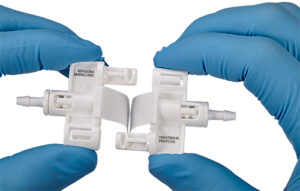Small-volume biopharmaceutical processes continue to grow as more biopharmaceutical, cell therapy and gene therapy companies develop products.
A 2021 Association for Regenerative Medicine (ARM) report states that there are 1,085 cell, gene and tissue-based therapy developers worldwide. These companies are engaged in many small-volume (<10L) processes including early-stage drug development and autologous therapies.
The increase in small-volume processes coincides with the ongoing need to create fast, reliable aseptic closed systems. Historically, few convenient options have existed to facilitate sterile processing. Tube welding is time consuming and labor intensive. Biosafety cabinets can only handle a limited number of processes at one time. Both of these methods also affect suite set-up and staff must plan for their availability.

So how do bioprocessors protect the integrity of their products while processing small batches quickly and efficiently? The answer lies in part with more production-friendly aseptic closed systems.
Older methods not optimized for today’s needs
Manual, open processing using a biosafety cabinet presents capacity constraints that reduce processing efficiency. Tube welding creates an aseptic closed system, but tube welders are expensive, with each unit easily costing $13,800 or more. Manufacturers must also accommodate welding equipment maintenance and downtime. Good operator technique is required to create a successful weld. Poor welds can increase contamination risk. Also, silicone tubing cannot be welded.
Bioprocessors have largely moved away from PVC and TPE tubing to silicone for its “cleaner” extractables and leachables profile. At some point, therapy processes likely will adopt the same stance, necessitating a different way to make aseptic connections. Single-use aseptic connectors can connect different sizes and types of tubing, including silicone.
Validated aseptic connectors maintain a sterile boundary between two adjoining single-use systems. Manufacturers rely on them for large-volume processes for their ease of use and ability to make sterile connections in non-sterile environments. Until recently, though, aseptic connectors for very small-bore tubing didn’t exist.
Small-volume applications and options for sterile closed systems
New ultra-compact aseptic connectors (MicroCNX® Series Connectors, CPC, St. Paul, Minn., USA) are designed specifically for small-volume processes involving widely used 1/16”, 1/8” and 3/32” tubing. These include sampling, seed train expansion and early cell culture processes with shaker flasks and rocker tables. Testing indicates that making a sterile connection with the new connector is up to four times faster than an operator using a tube welder1 , making operational efficiencies clear.
Use of aseptic connectors eliminates the need to purchase, calibrate, validate and maintain tube welders. There is no risk of faulty welds, welder breakdowns, or production delays due to weld equipment downtime. Unlike tube welders, aseptic connectors do not require valuable cleanroom space. There are many good reasons to use aseptic connectors and now a purpose-built option exists for the growing number of small-volume processes taking place globally.
For more information, visit www.cpcworldwide.com/micro
